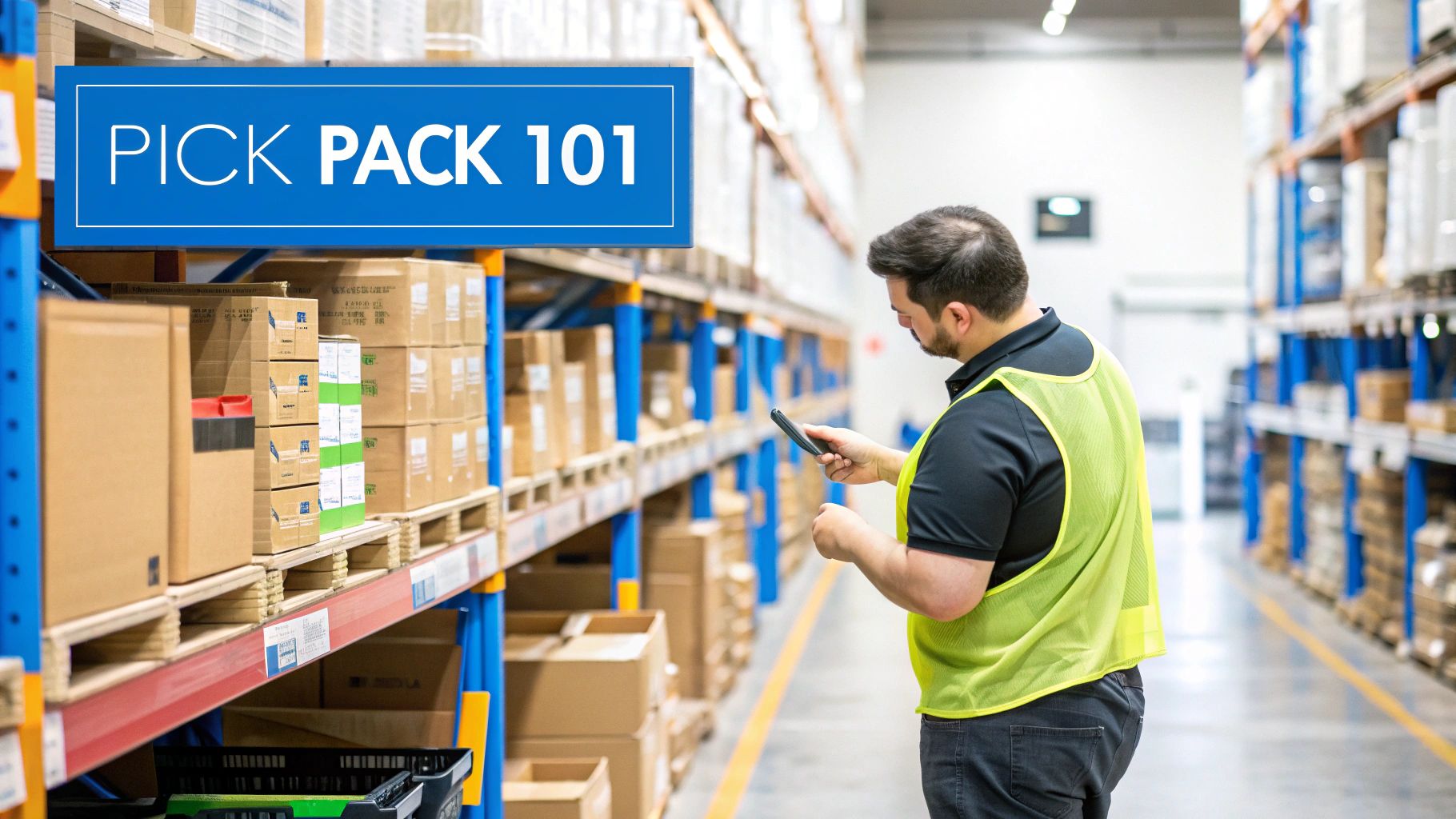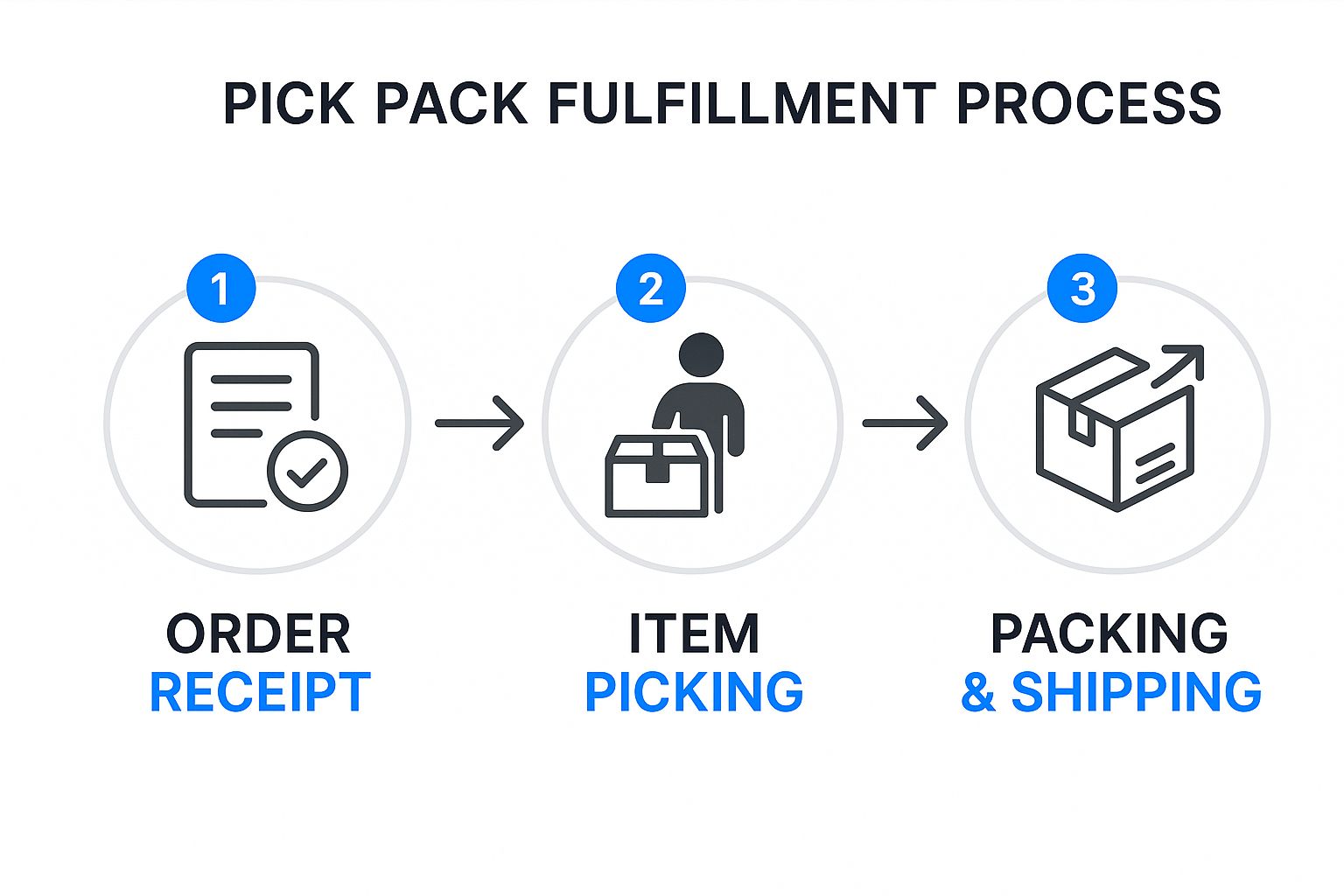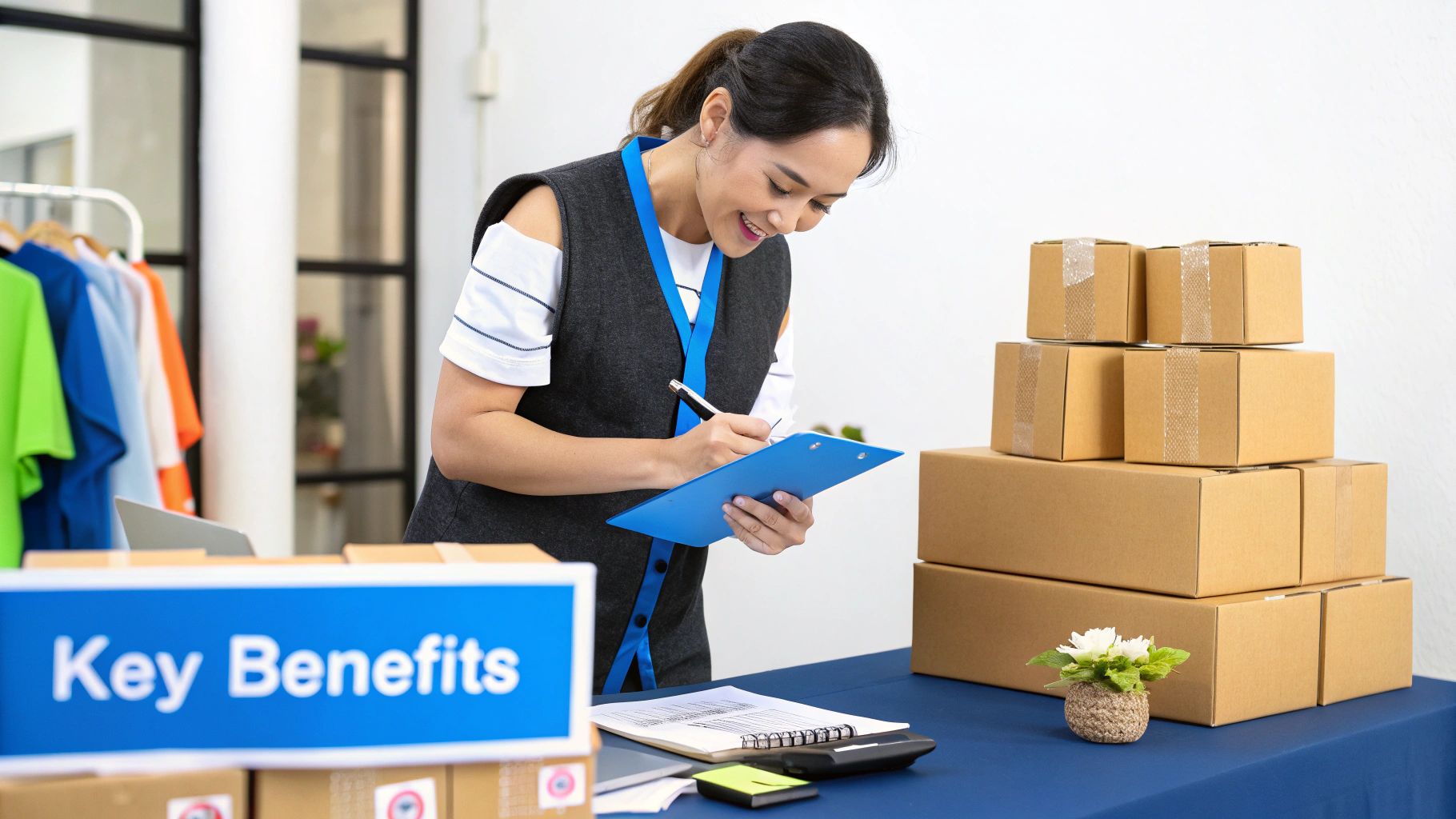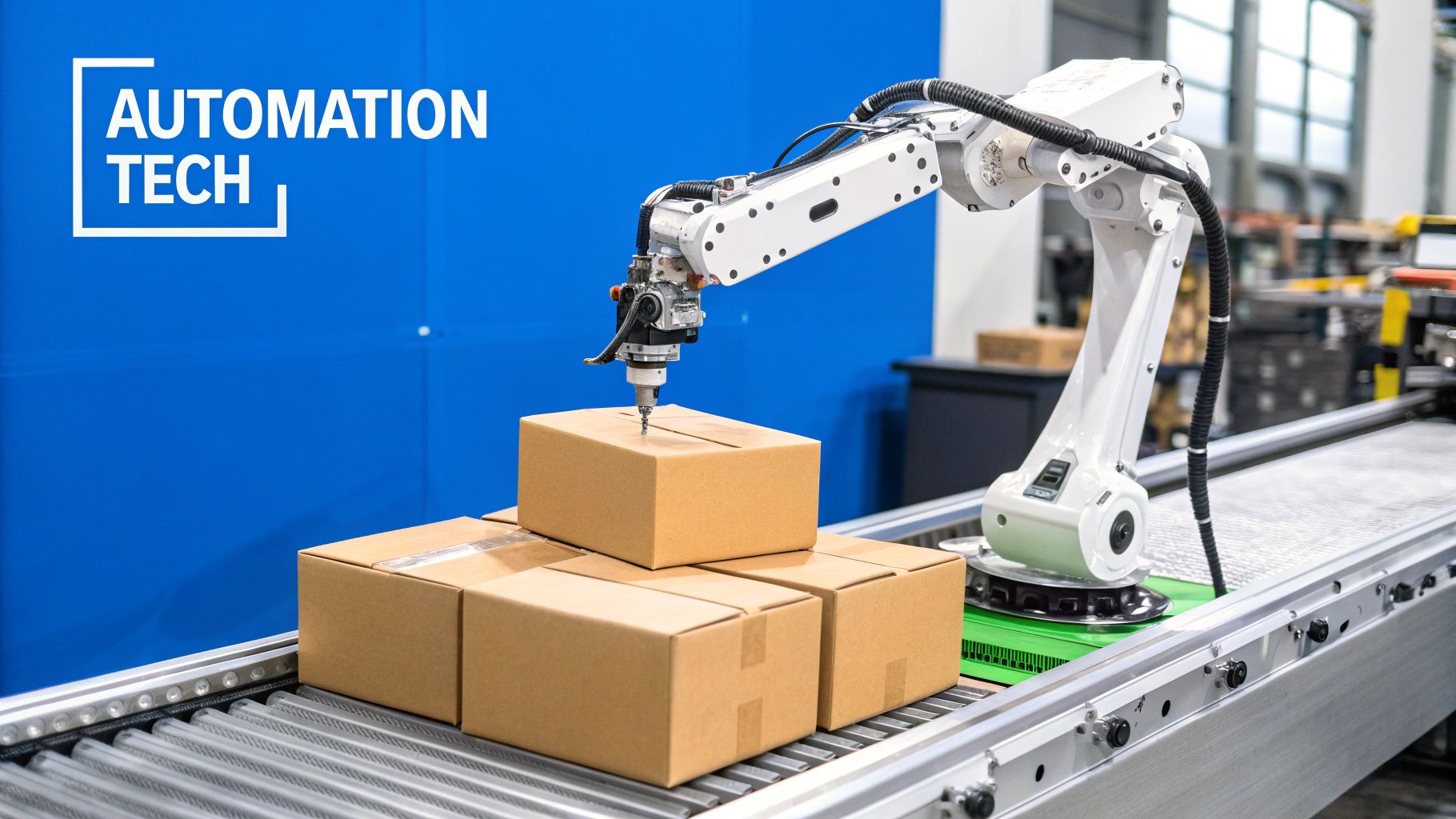At its core, pick pack fulfillment is the simple, physical process that takes a customer's click on "Buy Now" and turns it into a real package sitting on their doorstep. It’s the behind-the-scenes magic where warehouse associates pick items from shelves and pack them into boxes, directly shaping how quickly and accurately your customers get their hands on their new stuff.

Think of it like being a personal shopper in a giant supermarket. You get a detailed shopping list (the customer's order), navigate the aisles to grab each item ("picking"), and then bring everything to a station to be carefully bagged up for the trip home ("packing"). That’s pretty much what pick pack fulfillment looks like inside an ecommerce warehouse.
This two-step dance is the true engine of any online retail business. How well it runs determines whether a customer gets their order on time and with the right products inside. A clumsy, error-prone system leads to delays, wrong shipments, and unhappy customers—all things that can quickly tarnish a brand's reputation.
When it comes to getting this critical function handled, businesses generally go one of two ways. Figuring out which path to take is one of the first major decisions for any brand looking to get its fulfillment in order.
The accuracy and speed of your pick pack process are not just operational metrics; they are direct reflections of your brand's commitment to the customer. Getting this right is fundamental to building trust and encouraging repeat business in a competitive market.
In the end, it doesn't matter if you do it yourself or bring in an expert—a well-oiled pick pack machine is non-negotiable for success. It's how you keep the promise you made on your product page when that box finally arrives.
If you want to dig deeper into how this process can give your company an edge, you can learn more about how pick and packing is the secret weapon every ecommerce business needs. Mastering this system is the foundation upon which every scalable, customer-focused ecommerce business is built.
Ever wonder what happens in that magical moment after a customer clicks “buy”? That single action kicks off a finely tuned sequence of events inside a fulfillment center. The entire pick and pack journey is a systematic process designed for speed and accuracy, turning a digital order into a physical package ready for your customer's doorstep.
Let's break down this process into its four essential stages, following an order from the screen to the shipping dock. This visual guide shows the core steps in the journey, from the initial order receipt to the final packed shipment.

The image above really highlights how a seamless flow between receiving, picking, and packing is essential for an efficient operation. Each stage depends on the successful completion of the one before it, making the entire process a coordinated effort from start to finish.
The process begins the instant a customer completes their purchase. That digital transaction is automatically sent from your ecommerce platform—like Shopify or Amazon—straight to the warehouse management system (WMS).
Think of the WMS as the warehouse's brain. It processes the order details and generates a "picking list" or packing slip. This list is a precise set of instructions for the warehouse team, detailing what items to grab, how many of each, and exactly where they are located, right down to the specific SKU (Stock Keeping Unit).
With the picking list in hand, a warehouse associate, or "picker," starts the physical retrieval process. This is often the most labor-intensive part of fulfillment, so efficiency is everything. To make this stage as fast as possible, fulfillment centers use different strategies tailored to their order volume and product catalog.
Choosing the right picking method is a game-changer for warehouse productivity. Let's look at the most common approaches.
This table breaks down the four primary methods for picking items in a warehouse. Understanding these strategies can help you figure out which one best fits your business's order volume and product catalog.
Each of these picking methods is designed to minimize travel time and maximize the number of orders fulfilled per hour. Boosting efficiency in this stage is a key goal, and you can explore more ways to boost your ecommerce efficiency with optimized pick and pack fulfillment in our related guide.
Once all the items for an order have been picked and double-checked for accuracy, they arrive at a packing station. Here, another team member takes over, focusing on getting the order ready for its journey to the customer.
This stage is about more than just putting items in a box. It involves:
The final step is the handoff. The packed and labeled boxes are sorted by carrier (like USPS, FedEx, or UPS) and placed in designated areas for pickup. Once the carrier collects the packages and scans them into their system, the fulfillment cycle is almost complete.
At the same time, the WMS updates your ecommerce store with the tracking information. This automatically triggers a shipping confirmation email to the customer, closing the communication loop and giving them the transparency they expect.
This systematic approach is the backbone of the global e-commerce logistics network. The warehouse order-picking market, which includes these crucial pick and pack operations, was valued at around $10 billion. This reflects the huge reliance on e-commerce, which accounts for up to 15% of all global retail sales. Given that 60% of online retailers outsource at least some of their fulfillment, the role of expert 3PLs in executing this process flawlessly is more important than ever.

An efficient pick pack fulfillment process does a lot more than just get orders out the door—it’s a powerful engine for business growth and a cornerstone of your brand’s reputation. When you get it right, fulfillment stops being a simple operational cost and transforms into a strategic asset that directly boosts your bottom line, customer loyalty, and competitive edge.
Think of your fulfillment center as the final, critical touchpoint in the customer journey. Every single step, from the moment an item is picked off a shelf to the sealing of the shipping box, reinforces the promise you made on your product page. A well-oiled workflow is the key to unlocking its full potential.
One of the most immediate benefits of a sharp pick pack fulfillment strategy is a significant drop in costs. Let's be honest, inefficient processes are expensive. They’re plagued by wasted labor hours from disorganized picking routes and high error rates that lead to costly returns and reshipments. Every wrong item picked or package sent to the wrong address chips away at your profit margins.
By implementing structured workflows, clear inventory organization, and verification checks, you can slash these mistakes. This doesn't just cut the direct costs of fixing errors; it also reduces the labor needed to process each order, allowing your team to handle higher volumes without a proportional increase in headcount.
To really nail this, it's crucial to integrate your pick and pack process within broader supply chain management best practices. This holistic view ensures every stage, from procurement to delivery, works in harmony.
In ecommerce, the delivery experience is the customer experience. Order accuracy and shipping speed aren't perks anymore; they are fundamental expectations. A well-run pick pack operation ensures the correct items arrive on time, every time, which is the most basic and powerful way to build trust.
A recent study found that a staggering 98% of shoppers say shipping directly impacts their brand loyalty. A single negative delivery experience is often enough to keep a customer from ever buying from you again.
On the flip side, consistently accurate and fast deliveries create a fantastic impression of your brand. Customers who get exactly what they ordered, faster than they expected, are far more likely to become repeat buyers and brand advocates. It's a positive feedback loop that's essential for sustainable growth. Plus, accurate fulfillment means fewer returns, protecting your revenue and simplifying inventory management. For sellers on major platforms, this operational excellence is critical for optimizing ecommerce success through Amazon listing maintenance, where performance metrics directly impact your visibility.
In a crowded market, faster shipping speeds have become a key differentiator. When a customer is looking at two similar products, the one that promises quicker delivery often wins the sale. An optimized pick pack system is engineered for speed, shrinking the time between when an order is placed and when it's handed off to the carrier.
This capability lets you offer competitive shipping options, like two-day or even same-day delivery, without breaking the bank. By positioning your inventory strategically and fine-tuning warehouse processes, you can consistently outperform competitors who are still struggling with slower, less reliable fulfillment.
Finally, a robust fulfillment system provides the foundation you need to grow. An operation built on manual, disorganized processes will inevitably break down during high-demand periods like Black Friday or a viral marketing campaign. An optimized system, however, is built to scale.
Whether it’s through efficient layouts, batch picking strategies, or the integration of technology, a scalable pick pack fulfillment process can handle sudden sales spikes without sacrificing service quality. This elasticity ensures that you can pursue growth opportunities confidently, knowing your operational backbone can support the increased demand and continue delivering an exceptional customer experience.
Sooner or later, every ecommerce business hits a fork in the road: how are we going to handle pick pack fulfillment? This isn't just a simple operational question. It's a strategic choice that directly impacts your costs, your customer's experience, and your brand's ability to grow.
You've got three main paths to consider: doing it all yourself (in-house), hiring an expert to do it for you (3PL), or skipping inventory altogether (dropshipping). Each one comes with its own unique set of pros and cons, so let's break down which model might be the right fit for your business.
Going the in-house route means you own every single piece of the fulfillment puzzle. You're the one finding and leasing warehouse space, hiring the team, buying the equipment, and managing all the software. It’s a lot to take on, but it gives you the ultimate say over your brand experience.
The biggest perk here is total control. You can personally guarantee the quality of every packed box, toss in custom touches like handwritten notes, and make sure every single order is a perfect reflection of your brand. For new businesses focused on building a powerful brand identity from the ground up, this hands-on approach is often the best place to start.
But that level of control doesn't come free. The initial investment in warehouse space, shelving, and staff can be significant. And as your brand takes off, you'll be faced with the constant challenge of scaling up your operation—which always means more space, more people, and more logistical headaches.
Partnering with a third-party logistics (3PL) provider is like hiring a team of fulfillment specialists. You send your inventory to their warehouses, and they handle the rest. When an order comes in, they pick it, pack it, and ship it out for you.
The magic of a 3PL is tapping into their expertise and infrastructure without having to build it yourself. These companies live and breathe logistics. You get to benefit from their fine-tuned processes, advanced technology, and—perhaps most importantly—their deeply discounted shipping rates.
Outsourcing to a 3PL instantly gives you the power to scale. Whether you’re hit with a sudden holiday rush or a viral marketing success, a 3PL has the resources and staff to handle a massive influx of orders without missing a beat, something that would cripple an in-house operation.
The tradeoff, of course, is giving up some direct control. You're trusting an outside partner with a huge part of your customer experience. You'll also have ongoing costs to manage, from storage fees to per-item pick and pack charges. This makes it absolutely critical to find a 3PL partner whose commitment to quality matches your own.
Dropshipping flips the traditional fulfillment model on its head. Instead of holding your own inventory, you act as the storefront. When a customer places an order, you simply pass it along to your supplier or manufacturer, who then ships the product directly to the customer's doorstep.
This model is famous for its incredibly low barrier to entry. Since you aren't buying inventory upfront or paying for a warehouse, you can get a business off the ground with very little capital. It's a fantastic way to test out new product ideas or launch a brand without taking on a ton of financial risk.
The major catches are razor-thin profit margins and a near-total lack of control over the customer experience. You're at the mercy of your supplier for everything from product quality to packing standards and shipping times. Any slip-up on their end reflects directly on your brand, and trying to solve customer service issues when you're the middleman can get messy.
Ultimately, the right choice boils down to what matters most to you. If brand control is non-negotiable, in-house is your best bet. If you’re all about rapid growth and operational efficiency, a 3PL is a game-changer. And if you want to test the waters with minimal risk, dropshipping offers a flexible on-ramp to the world of ecommerce.

Outsourcing your pick pack fulfillment is a massive decision. You’re not just hiring a service; you're choosing a partner who will become a physical extension of your brand. The right third-party logistics (3PL) provider can be a powerful engine for growth, while the wrong one can create logistical nightmares and tarnish your reputation.
Think of it like hiring a co-pilot for your business. You need someone with the right skills, reliable equipment, and a crystal-clear understanding of where you're headed. This selection process requires a hard look at several key areas to make sure your chosen partner aligns perfectly with your business needs and long-term goals.
The digital handshake between your e-commerce store and your 3PL’s warehouse is arguably the most critical connection. A seamless, real-time flow of information isn't a "nice-to-have"—it's completely non-negotiable. The first thing you must confirm is that their Warehouse Management System (WMS) integrates flawlessly with your sales platforms, whether that's Shopify, Amazon, or WooCommerce.
A shoddy integration will cause chaos. We're talking lost orders, inaccurate inventory counts, and maddening shipping delays, all of which kill customer trust. Get granular with your questions:
A modern, robust tech platform isn't just a convenience. It's the very foundation of an efficient and scalable fulfillment operation.
Where your fulfillment partner stores your inventory directly impacts your shipping costs and how fast your products get to customers. A 3PL with a single, centrally located warehouse might seem simple enough, but a partner with multiple facilities strategically dotted across the country can be a total game-changer. This is called a distributed inventory model, and it's all about storing products closer to your customers.
That proximity dramatically shrinks shipping zones, which in turn slashes your shipping costs and shortens delivery times. For any e-commerce brand today, offering fast and affordable shipping isn't a perk; it's a major competitive advantage. For a deeper dive into this, our guide on evaluating fulfillment partners for your ecommerce business has even more to chew on.
Fulfillment pricing can be notoriously complex, and hidden fees are a classic pitfall. A transparent partner will give you a clear, itemized breakdown of every potential charge. You need absolute clarity on the following:
Be extremely wary of partners who hit you with an unusually low initial quote without detailing every single service. The best partners are upfront about their entire pricing model so you can accurately forecast your expenses without any nasty surprises down the road.
Finally, make sure this partner can grow with you. What happens during Black Friday or your biggest sales season? You need to ask about their ability to handle huge, sudden spikes in order volume. A provider that can easily scale its labor and resources up or down is invaluable.
It’s also crucial to consider their experience with products like yours. If you sell fragile electronics, apparel with a million SKUs, or items that need special handling, you need a partner who already knows the ropes. Finding a specialist ensures your unique needs are met with expertise, not guesswork.
The world of pick pack fulfillment is running on a simple, universal truth: customers want their stuff faster and more accurately than ever before. Meeting those expectations isn't just about tweaking the old way of doing things; it's about a complete overhaul of how orders get from shelf to doorstep. The future is being built right now with automation, robotics, and a total rethink of warehouse strategy.
These aren't small upgrades. We're talking about moving fulfillment far beyond the limits of human speed and stamina. Think robotic arms with delicate grippers picking fragile items 24/7 without a single mistake, or autonomous mobile robots (AMRs) zipping across warehouse floors, bringing bins to packers. This isn't a sci-fi movie scene—it's the new normal for top-tier fulfillment centers.
Automation is the engine driving this new era. It’s not just about going faster, but about building a smarter, safer, and dead-accurate warehouse. A few key technologies are leading the charge:
But maybe the biggest change is where fulfillment is happening. A massive trend is the move toward hyperlocal fulfillment centers—often called micro-hubs—which are small, intensely automated facilities planted right in the middle of cities.
Forget the giant warehouses on the outskirts of town. These new hubs might be in the back of a repurposed retail store or a compact urban module, putting inventory just a few miles from the customer. This is the secret sauce for same-day or even two-hour delivery, and it dramatically slashes last-mile costs and the carbon footprint of each order. You can find more details on how fulfillment trends are reshaping e-commerce on quivo.co.
The goal isn't just fast fulfillment anymore; it's practically instant. By moving the warehouse closer to the customer, brands can finally meet the demand for immediate gratification and build a more sustainable logistics network in the process.
Ultimately, all these trends are pointing to a new reality for pick pack fulfillment—one that's faster, smarter, and more responsive than we ever thought possible.
Diving into the world of pick pack fulfillment can bring up a lot of questions, especially when your brand is starting to grow. Getting straight, clear answers is the key to making the right calls for your business. Let's dig into some of the most common things business owners want to know.
This is the big one, and the honest answer is: it varies. The cost depends on your 3PL partner, how many orders you're shipping, and how complex your products are to handle. But generally, you can expect to pay a fee for the first item picked in an order (often between $2.00-$4.00) and then a smaller fee for each additional item (usually around $0.50-$2.00).
But don't stop there. Other common charges can include:
Always, always ask for a detailed quote that breaks down every potential cost. You want a partner who is completely transparent with their pricing—no surprises.
The heart and soul of any modern fulfillment operation is its Warehouse Management System (WMS). Think of it as the central nervous system that keeps everything connected and running on time.
A solid WMS plugs directly into your ecommerce store to pull in new orders, track inventory levels in real-time, create the most efficient picking lists for the warehouse team, and print shipping labels. It's the software that gives you the data you need to find bottlenecks and make your whole operation run better. If you decide to work with a 3PL, they'll provide the WMS and handle the entire integration for you.
You don’t need a massive warehouse to get started. The first step is dedicating a clean, organized space just for your inventory. Simple shelving with clear labels and SKUs is all you need to make products easy to find.
The real secret is building a repeatable, consistent workflow from day one. Print a packing slip for every order, gather all the items for that single order at once, and create a packing station where all your supplies are within easy reach. Nailing this standardized manual process is the foundation you'll need to scale successfully later on.
While people often use these terms interchangeably, they describe two very different functions. A traditional warehouse is all about long-term storage. It's a static place where goods are kept safe until they're needed somewhere else down the supply chain.
A fulfillment center, on the other hand, is a buzzing hub of activity built for one thing: processing customer orders quickly. Its entire purpose is to receive inventory and then execute the pick pack fulfillment process to get products out the door and on their way to customers as fast as possible. The focus is always on speed, accuracy, and turning over inventory.
Ready to stop worrying about logistics and focus on growing your brand? Simpl Fulfillment offers transparent pricing, seamless integrations, and expert handling for every order. Discover how our 3PL services can scale your business today.